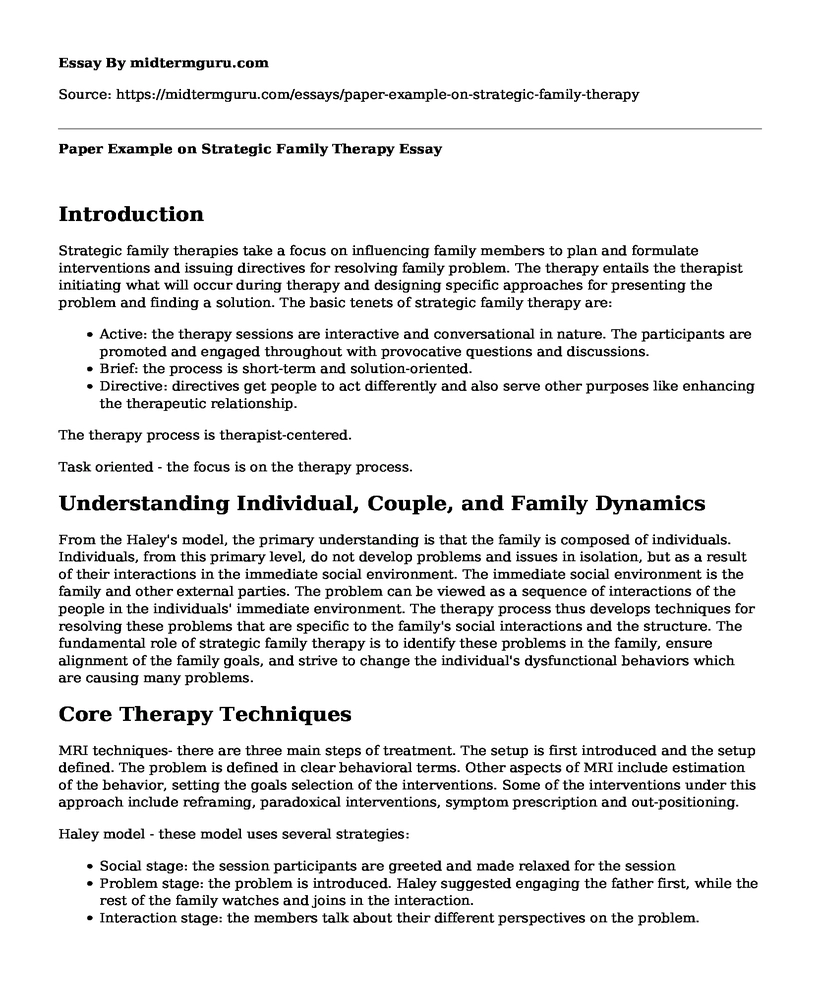Introduction
Strategic family therapies take a focus on influencing family members to plan and formulate interventions and issuing directives for resolving family problem. The therapy entails the therapist initiating what will occur during therapy and designing specific approaches for presenting the problem and finding a solution. The basic tenets of strategic family therapy are:
- Active: the therapy sessions are interactive and conversational in nature. The participants are promoted and engaged throughout with provocative questions and discussions.
- Brief: the process is short-term and solution-oriented.
- Directive: directives get people to act differently and also serve other purposes like enhancing the therapeutic relationship.
The therapy process is therapist-centered.
Task oriented - the focus is on the therapy process.
Understanding Individual, Couple, and Family Dynamics
From the Haley's model, the primary understanding is that the family is composed of individuals. Individuals, from this primary level, do not develop problems and issues in isolation, but as a result of their interactions in the immediate social environment. The immediate social environment is the family and other external parties. The problem can be viewed as a sequence of interactions of the people in the individuals' immediate environment. The therapy process thus develops techniques for resolving these problems that are specific to the family's social interactions and the structure. The fundamental role of strategic family therapy is to identify these problems in the family, ensure alignment of the family goals, and strive to change the individual's dysfunctional behaviors which are causing many problems.
Core Therapy Techniques
MRI techniques- there are three main steps of treatment. The setup is first introduced and the setup defined. The problem is defined in clear behavioral terms. Other aspects of MRI include estimation of the behavior, setting the goals selection of the interventions. Some of the interventions under this approach include reframing, paradoxical interventions, symptom prescription and out-positioning.
Haley model - these model uses several strategies:
- Social stage: the session participants are greeted and made relaxed for the session
- Problem stage: the problem is introduced. Haley suggested engaging the father first, while the rest of the family watches and joins in the interaction.
- Interaction stage: the members talk about their different perspectives on the problem.
- Milan Technique: this technique involved sessions divided into five main parts: pre-session, session, intersession, and intervention stage.
Comparing Strategic Model of Family Therapy With Others
Strategic family therapy and other theories discussed are critical in formulating interventions where they are needed. Both strategic family therapy and structural family therapy helps to focus on changing the dynamics within the family so that optimal family functioning is realized. Structural therapy is strength-based and also outcome oriented while strategic family therapy takes the approach of using task-oriented intervention strategies. While the two theories approach the process of therapy and change differently, they play a fundamental role in drawing change. Both of them utilize paradoxical intervention strategy in their therapy process to change bad habits into good habits. On the contrary, due to the difference in the theories, there are different intervention strategies. The two also have different stages of therapy and also goals to be realized. The joining factor is that these stages, while they are different, all aim at one main goal of enabling the therapist to find the core problem and helping the affected parties to come up with solutions.
Interface With Gender, Class, Race, Sexual Orientation, and Religion/Spirituality
Gender, class, sexual orientation and religious affiliations are important in the whole process of marital or family therapy. In many societies across the world, inequalities between the genders still persist. Gender and gender roles define interactions within the family. In most societies, for instance, men learn that they are required to be on top of the decision-making process. Regarding gender roles, the weight of issues often affect one gender more than the other hence consideration has to be made. Regarding sexual orientation, therapy is often complicated due to divergent attitudes that gays and lesbians face. They exist in a culture that mostly views sexual relationships from the context of opposite sex, and not same sex. Spiritual awareness and competence is a critical tool that can enhance healing. While recognizing so, exploring this direction can be hard due to the differences presented by religious perspectives. Interventions sought may also bring conflicts from the perspective of racial and cultural affiliation and it is critical for the therapist to have overall cultural competence.
Reactions to the Theory
Strategic family theory's steps play a critical role in enabling families and individuals to confront the roots of their problems. Families are known to engage in complex problems that are mostly developed in a sequential manner. Strategic famly therapy process helps in altering the psychological challenges that emanates from problematic interactions between individuals in the family institution. The therapy process and its steps makes it easy to understand the source of such difficulties and help individuals make peace with others.
References
Metcalf, L., & LPC-S, L. S. (2011). Marriage and family therapy: A practice-oriented approach. Springer Publishing Company.
Cite this page
Paper Example on Strategic Family Therapy. (2022, Oct 25). Retrieved from https://midtermguru.com/essays/paper-example-on-strategic-family-therapy
If you are the original author of this essay and no longer wish to have it published on the midtermguru.com website, please click below to request its removal:
- Assignment Example on Mental Health Assessment: Acute Confusion (Delirium)
- Research Paper on Social Media and Mental Health
- Critical Essay on The Global Grapevine: Why Rumors of Terrorism, Immigration, and Trade Matter
- Managing Anxiety: Establishing a Therapeutic Alliance - Essay Sample
- How Mental Health Affects People Post Military War in Iraq and Afghanistan - Essay Sample
- Overcoming Depression: Treatment Options for Recovery - Essay Sample
- Moral Philosophy: Examining Right and Wrong in Existence - Essay Sample







